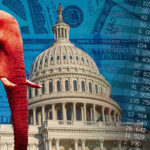The Dow (DJIA) traded as low as 24,122 in late-Monday afternoon trading. By Friday’s open, the Dow had rallied 1,457 points, or 6.0%, to 25,579. Relatively speaking, the Dow was a tame kitten. From Monday’s intraday lows, the Nasdaq100 rallied as much at 7.8%. The Semiconductors won this week’s Wild Animal competition, rallying 12.7% (week’s lows to highs). At 11.9%, the Biotechs were a close second. The Homebuilders (XHB) rallied as much as 11.3% before ending the week with a gain of 7.3%.
A couple obvious questions come to mind: Bear market rally or just another “buy the dip, don’t be one” opportunity for a market again ready to scale new heights? Is President Trump now ready to strike a trade deal with China – or was he just goosing markets ahead of the midterms?
Let’s start with the markets. They certainly had the likeness of a classic “rip your face off” bear market rally. The Goldman Sachs Most Short index surged 9.0% off Monday lows. For the week, this index rose 6.1%, showing off a 2.5 beta versus the S&P500’s return (6.1%/2.4%). In the semiconductor space, heavily shorted On Semiconductor, NXP Semiconductor, AMD and Micron Technology gained 23.9%, 18.5%, 14.8% and 13.9%, respectively. A long list of heavily shorted retail stocks gained double-digits, as the Retail index (XRT) surged 4.3% for the week.
There were a number of heavily shorted biotech stocks that posted 20% plus gains for the week. A bunch of regional banks rose between five and nine percent. And I’d be remiss for not mentioning (everyone’s favorite short) Tesla. In just 10 sessions, Tesla rallied (38%) from a low of $253 to Friday’s $346 close.
It’s certainly worth noting that short squeeze dynamics were not limited to U.S. equities. Let’s start at the epicenter of global crisis dynamics, the big banks. Hong Kong’s Hang Seng (Chinese) Financials index rallied as much as 8.3% off the week’s lows, to end the week up 6.3%. Japan’s TOPIX Bank index rallied 5.4% for a weekly gain of 3.9%. Italian banks rose 6.1% this week. European banks (STOXX600) rallied 7.4% off Monday lows, to post a weekly rise of 5.4%. Deutsche Bank recovered almost 11% to finish the week up 8.8%.
The Wildness definitely included the emerging markets. The popular EEM ETF rallied as much as 10% off of Monday’s lows to end the week up 5.6%. Major stock indices were up 7.0% in Argentina, 6.8% in South Africa, 5.0% in India, 4.4% in Taiwan and 4.0% in Turkey. Brazil’s Ibovespa index gained 3.4% this week, boosting gains from June trading lows to 25%. Curiously, the Brazilian real declined 1.6% this week. Overall for the week, key EM currencies were caught up in the global short squeeze. The Argentine peso jumped 3.8%, the Turkish lira 3.0%, the South African rand 2.1%, the South Korean won 1.8%, the Indonesian rupiah 1.8%, and the Indian rupee 1.4%. Down 3.3%, the Mexican peso was the glaring exception.
Ten-year Treasury yields traded as low as 3.06% in nervous Monday trading. And while yields ended the week significantly higher, it’s worth noting that the October 5th closing high of 3.23% was only 17 bps higher than Monday’s “risk off” low yield. That’s a meager pullback in yields considering the drubbing global equities were taking.
There’s a number of possible explanations for the recent stickiness of Treasury yields, including: 1) Inflationary pressures have attained more momentum than in the recent past. 2) Global de-risking/deleveraging is impacting global market liquidity more generally, with effects even in safe haven sovereign debt markets. 3) U.S. fixed-income markets have succumbed to deleveraging and resulting waning liquidity. 4) Markets now don’t expect the Fed to respond to “risk off” dynamics as early or aggressively as in the past. 5) The U.S. economy maintains significant momentum, especially in terms of tight labor markets.
Ten-year Treasury yields jumped eight bps Friday on the back of stronger-than-expect payrolls data. At 3.21%, yields are only two bps below the seven-year highs posted a month ago. October’s 250,000 job gains were a full 50,000 above expectations, as tight labor markets turn tighter by the day. After 10 months, y-t-d job gains of 2,125,000 are running 18% above comparable 2017. October’s 32,000 added manufacturing jobs were double expectations, with 2018’s 227,000 added manufacturing jobs 64% above comparable 2017. Last month’s 3.7% unemployment rate compares to October 2017’s 4.1%. And October’s 3.1% y-o-y gain in Average Hourly Earnings was the strongest since April 2009 – and compares to the year ago 2.3%. If I were a bond, I’d be on edge.
November 2 – Bloomberg (Christopher Maloney): “The bloodbath last month in the mortgage-bond market points to what the future may be like without Federal Reserve hand holding. Investors are now wondering if anyone will step in to stop the bleeding. Returns on mortgage-backed securities in October lagged Treasuries by 37 bps, the most since November 2016… Last month’s weakness coincided with the Fed ending its mortgage purchases as it winds down the $1.7 trillion MBS portfolio it amassed since the financial crisis to support the market… In a situation rarely seen over the last four decades, there isn’t going to be a government entity — which before the financial crisis included Fannie Mae and Freddie Mac — at hand to provide liquidity for mortgage-backed securities…”
Benchmark MBS yields jumped 10 bps Friday to 4.06%, the high going back to April 2011. Yields surged 16 bps this week and are now up 108 bps y-t-d.
My thesis holds that the global Bubble has been pierced at the “Periphery.” After erupting at the “Periphery,” de-risking, deleveraging and Contagion have been gravitating toward the “Core.” Sinking MBS prices (spiking yields) confirm my view that “Periphery to Core Crisis Dynamics” have now attained important momentum at the “Core.”
My assumption has been that a most-prolonged period of ultra-low rates and QE liquidity backstops has heavily incentivized leveraged speculation around the world. Globally, levered “carry trade” strategies (borrow cheap in one currency to purchase higher-yielding securities elsewhere) have proliferated. It’s worth noting that the NY Fed’s holdings on behalf of foreign (chiefly central bank) owners of Treasuries/Agencies dropped $19.8bn last week (to a 3-month low $3.414 TN), the biggest decline since April. I see this as likely evidence of speculative de-leveraging, capital flight, and foreign central bank purchases (dollar sales) to support their currencies. For years now, speculative international flows to EM were at least partially recycled into U.S. markets (including central bank purchases of Treasuries and Agencies). It would appear these flows have slowed significantly – and perhaps are at risk of reversing as global deleveraging gains further momentum.
I believe huge speculative leverage has accumulated here at home as well. I have posited that higher-yielding corporate Credit has been as bastion of speculative excess. And going all the way back to the early-nineties, the mortgage arena has been treasured by a flourishing leveraged speculating community. The MBS marketplace has generally been highly liquid, with securities easily financed in the booming “repurchase agreement” (“repo”) market.
The above Bloomberg article noted a “situation rarely seen over the last four decades.” The market is questioning the source of market liquidity going forward. This has become a pressing issue now that the Fed has begun liquidating its MBS portfolio. The predicament is compounded by the GSE’s unsound financial position, one that limits their capacity to provide a powerful liquidity backstop as they did throughout the nineties and for much of the mortgage finance Bubble period (until their growth was impeded by revelations of accounting fraud).
If it is correct that de-risking/deleveraging dynamics have reached the “Core,” the MBS marketplace faces challenges. In particular, as the hedge funds suffer mounting losses elsewhere (i.e. stocks, global markets, corporate Credit…), they will turn more averse to risk generally, including a vulnerable MBS marketplace. And as the speculator community moves to de-risk in MBS, it is not obvious who will step up to buy. Alternatively, as they hedge MBS interest-rate risk by shorting Treasuries, this places additional selling pressure on a Treasuries marketplace already facing massive issuance and formidable Fed liquidations.
Mortgage-backed securities are a problematic instrument. When yields drop, borrowers refinance and become more likely to purchase new homes. MBS owners get their money back much sooner than they would prefer (with lower reinvestment yields). When yields rise, MBS duration increases as borrowers hold their attractive mortgages longer. MBS holders are stuck for longer.
Over recent decades, this fundamental MBS weakness was more than offset by two critical factors: One, the GSE’s eagerness to purchase securities, especially during deleveraging/crisis backdrops. Second, the Fed’s willingness to aggressively cut interest-rates in the event of “risk off” marketplace liquidity issues (or, better yet, to buy $1.8 TN of MBS). With rates and yields currently rising, MBS vulnerability is obvious. Meanwhile, traditional offsetting liquidity advantages (GSEs and Fed) are anything but readily apparent going forward.
After the mortgage finance Bubble collapse, it was only natural to anticipate a significant widening of risk premiums throughout the mortgage complex. I expected a fundamental repricing of mortgage Credit, but this was not to be. The Fed slashed short-term borrowing costs to zero and expanded its balance sheet to $4.5 TN, including the purchase of $1.8 TN of mortgage-backed securities. Moreover, after a period of shrinkage, the GSEs again began expanding their mortgage holdings. Between expanding Fed and GSE holdings and the relatively weak household demand for mortgage borrowings, mortgage borrowing costs collapsed.
MBS yields averaged 7.75% during the nineties, and then sank to 6.00% during 2000 through 2007. Well, benchmark MBS yields averaged an extraordinary 3.25% between 2009 and 2017. This pricing anomaly might have finally run its course, with major ramifications for the mortgage marketplace, overall securities market liquidity and the general economy. For a very long time, the MBS marketplace acted as both a key source of marketplace liquidity and a centerpiece of government (Treasury and Federal Reserve) policy activism. The Fed’s post-crash efforts to collapse borrowing costs both significantly reduced household mortgage payments, while enriching the holders of mortgage securities. But now losses for levered holders of MBS are mounting, including for the Fed and the barely capitalized GSEs. Payback Time.
I don’t want to dismiss the importance of the unfolding U.S. and China trade war – or possible successful negotiations. A trade agreement would be market positive. The markets were buoyed this week by constructive comments from President Trump and Chinese officials. Commentators were, however, understandably skeptical of the timing just days before the midterms. Yet it doesn’t take highly speculative “oversold” markets much to be incited into a decent short squeeze.
At the same time, I don’t believe the U.S./China trade spat has been the major force behind global de-risking/deleveraging. Stated differently, this dispute worsened the situation but was not the catalyst behind the bursting of the global Bubble. Indeed, from a de-risking/deleveraging perspective, Friday’s yield jump was ominous. Fixed-income investors and speculators have no doubt been hoping that “risk off” would provide some relief on the market yield front. With an equities short squeeze and strong payrolls data, the pressure just became too intense.
MBS yields have broken out to the upside, with corporate and Treasury yields close behind. Equity market players are certainly hoping a trade deal is in the works. Fixed-income players not so much. And it is within fixed-income on a global basis that problematic leverage lurks. Leveraged “risk parity” strategies saw some relief from this week’s equities rally, but they must look at rising market yields with increasing trepidation.
We’re now only days from the midterms. It’s an especially difficult event to handicap from a market standpoint. Red wave or blue wave? I don’t recall midterm elections where the outcome had the potential to be so market moving. Blue wave – big. Red wave – big. Making things all the more interesting, there has been major market instability heading into the elections. This ensures there have been major shorting and hedging efforts – to hedge/speculate both on the markets and midterm outcomes.
I’ll assume large quantities of put options and derivative protection have been purchased. In the event of a red wave, there is ample firepower for an unwind of hedges and short covering to spark a rally. In the event of a blue wave, a market downdraft would see aggressive hedge-related selling by players caught on the wrong side of derivative protection previously sold. The stock market response to the anticipated blue House and red Senate split decision is not clear at all. But maybe equities have become a diversion. In a week where the focus was on short squeezes and tantalizing equities rallies, perhaps the more decisive development was in surging MBS and corporate yields.
For the Week:
The S&P500 rose 2.4% (up 1.8% y-t-d), and the Dow gained 2.4% (up 2.2%). The Utilities slipped 0.6% (up 0.6%). The Banks surged 4.8% (down 6.9%), and the Broker/Dealers rallied 5.4% (down 0.6%). The Transports jumped 4.0% (down 2.3%). The S&P 400 Midcaps rose 3.7% (down 2.0%), and the small cap Russell 2000 surged 4.3% (up 0.8%). The Nasdaq100 gained 1.6% (up 8.9%). The Semiconductors surged 7.5% (down 1.1%). The Biotechs jumped 5.8% (up 13.7%). With bullion about unchanged, the HUI gold index rallied 3.3% (down 22.3%).
Three-month Treasury bill rates ended the week at 2.27%. Two-year government yields rose 10 bps to 2.91% (up 102bps y-t-d). Five-year T-note yields gained 13 bps to 3.04% (up 83bps). Ten-year Treasury yields jumped 14 bps to 3.21% (up 81bps). Long bond yields rose 15 bps to 3.46% (up 72bps). Benchmark Fannie Mae MBS yields surged 16 bps to 4.08% (up 112bps).
Greek 10-year yields were unchanged at 4.27% (up 20bps y-t-d). Ten-year Portuguese yields slipped two bps to 1.88% (down 6bps). Italian 10-year yields dropped 13 bps to 3.32% (up 131bps). Spain’s 10-year yields added a basis point to 1.57% (up 1bp). German bund yields jumped eight bps to 0.43% (unchanged). French yields gained five bps to 0.79% (unchanged). The French to German 10-year bond spread narrowed three to 36 bps. U.K. 10-year gilt yields rose 11 bps to 1.49% (up 30bps). U.K.’s FTSE equities index rallied 2.2% (down 7.1%).
Japan’s Nikkei 225 equities index rallied 5.0% (down 2.3% y-t-d). Japanese 10-year “JGB” yields increased two bps to 0.13% (up 8bps). France’s CAC40 recovered 2.7% (down 4.0%). The German DAX equities index jumped 3.1% (down 10.6%). Spain’s IBEX 35 equities index rose 3.0% (down 10.5%). Italy’s FTSE MIB index rallied 3.8% (down 11.3%). EM equities were mostly higher. Brazil’s Bovespa index gained 3.4% (up 15.7%), while Mexico’s Bolsa declined 1.0% (down 7.9%). South Korea’s Kospi index recovered 3.4% (down 15.1%). India’s Sensex equities index rallied 5.0% (up 2.8%). China’s Shanghai Exchange jumped 3.0% (down 19.1%). Turkey’s Borsa Istanbul National 100 index surged 4.0% (down 18.4%). Russia’s MICEX equities index jumped 3.7% (up 12.7%).
Investment-grade bond funds were hit with outflows of $3.753 billion, and junk bond funds saw outflows of $1.043 billion (from Lipper).
Freddie Mac 30-year fixed mortgage rates slipped three bps to 4.83% (up 89bps y-o-y). Fifteen-year rates declined six bps to 4.23% (up 96bps). Five-year hybrid ARM rates dropped 10 bps to 4.04% (up 81bps). Bankrate’s survey of jumbo mortgage borrowing costs had 30-yr fixed rates down three bps to 4.79% (up 61bps).
Federal Reserve Credit last week declined $15.3bn to $4.121 TN. Over the past year, Fed Credit contracted $300bn, or 6.8%. Fed Credit inflated $1.310 TN, or 47%, over the past 313 weeks. Elsewhere, Fed holdings for foreign owners of Treasury, Agency Debt dropped $19.8bn last week to $3.415 TN. “Custody holdings” were up $49bn y-o-y, or 1.4%.
M2 (narrow) “money” supply jumped $25.5bn last week to a record $14.287 TN. “Narrow money” gained $541bn, or 3.9%, over the past year. For the week, Currency increased $1.9bn. Total Checkable Deposits rose $29.4bn, while Savings Deposits declined $16.6bn. Small Time Deposits increased $3.7bn. Retail Money Funds gained $7.1bn.
Total money market fund assets added $2.7bn to $2.884 TN. Money Funds gained $155bn y-o-y, or 5.7%.
Total Commercial Paper slipped $0.6bn to $1.087 TN. CP gained $39.7bn y-o-y, or 3.8%.
Currency Watch:
October 30 – Bloomberg (Keith Bradsher): “As the United States and China swap threats and mete out increasingly punishing tariffs, the world is watching to see whether Beijing turns to one of its most potent economic weapons. It involves the number 7. China’s currency, the renminbi, has been gradually losing value since mid-April, and on Tuesday it was at its weakest point in a decade. If the currency weakens any further, it could fall below the psychologically important level of 7 renminbi to the dollar. The last time it took more than 7 renminbi to buy a dollar was in May 2008, as the world was slipping into a financial crisis.”
October 30 – Bloomberg (Tian Chen): “How much further will China’s currency slide after it touched the weakest level in a decade on Tuesday? The answer may depend in large part on whether Beijing can keep capital outflows under control. Official figures released over the past few weeks suggest money is increasingly leaving China’s borders, a reminder that motivated citizens and companies still have ways to get their cash out despite a tightening of capital controls after the country’s shock devaluation in 2015. While there’s little to suggest a stampede for the exits is imminent, the risk increases with every tick lower in the yuan.”
The U.S. dollar index was little changed at 96.484 (up 4.7% y-t-d). For the week on the upside, the New Zealand dollar increased 2.2%, the South African rand 2.1%, the South Korean won 1.8%, the Australian dollar 1.5%, the British pound 1.1%, the Swedish krona 0.8% and the Singapore dollar 0.3%. For the week on the downside, the Mexican peso declined 3.3%, the Brazilian real 1.6%, the Japanese yen 1.1%, the Swiss franc 0.7%, the Norwegian krone 0.2% and the euro 0.1%. The Chinese renminbi rallied 0.77% versus the dollar this week (down 5.57% y-t-d).
Commodities Watch:
October 30 – Bloomberg (Ranjeetha Pakiam): “Goldman Sachs… says that ‘fear’ has made a comeback and gold is benefiting as stocks slide and investors fret more about the possibility that the U.S. economy may tumble back into recession. Bullion’s recent advance ‘happened on the back of the market sell-off and spike in volatility,’ analysts including Mikhail Sprogis and Jeffrey Currie, wrote… ‘In our view, it represents a rebound in fear-related demand for gold with ETFs beginning to build after several months of declines.’”
The Goldman Sachs Commodities Index dropped 3.1% (up 1.9% y-t-d). Spot Gold was little changed at $1,233 (down 5.4%). Silver was about unchanged at $14.475 (down 14%). Crude sank another $4.73 to $62.87 (up 4%). Gasoline dropped 6.3% (down 5%), while Natural Gas rallied 2.9% (up 12%). Copper jumped 2.5% (down 15%). Wheat added 0.7% (up 19%). Corn gained 1.0% (up 6%).
Market Dislocation Watch:
October 31 – Reuters (Lewis Krauskopf): “Gridlock, Blue Sweep or Red Repeat? Wall Street is closely watching the U.S. midterm Congressional elections next week, as policy decisions that could sway the economy, corporate decision-making and consumer spending hinge on the results. Should his fellow Republicans maintain or extend their grip on Congress, President Donald Trump may be emboldened to pursue more of his political agenda, including further tax reforms. By contrast, Democratic gains that allow the party to control the House of Representatives, and possibly the Senate, could stifle Trump’s policy aims and perhaps lead to attempts to impeach him.”
October 30 – Reuters (Richard Leong): “A measure of strain in U.S. money markets grew to its widest level in 2-1/2 months on Tuesday as a gauge of interbank borrowing costs increased for a 10th straight session to a fresh decade high. The London interbank offered rate for banks to borrow three-month dollars from each other climbed 1.4 bps to 2.54100%, the highest since October 2008. LIBOR is the rate benchmark for $200 trillion of dollar-denominated financial products, mainly interest rate swaps and floating-rate loans.”
Trump Administration Watch:
November 2 – Bloomberg (Brendan Scott): “As recently as Sunday, Donald Trump was telling supporters China was “not ready” to cut a deal to end their trade war. Last night, he decided it is. The U.S. president ordered Cabinet officials to draft terms for an agreement between the world’s two largest economies, Jenny Leonard, Saleha Mohsin and Jennifer Jacobs report. The breakthrough came after Trump’s “long and very good” phone call with Chinese counterpart Xi Jinping – their first confirmed conversation in six months. ‘They want to make a deal,’ Trump told a rally… ‘He wants to do it.’ Global markets rallied on the news. But Chinese state media said the call came at Trump’s request, suggesting another catalyst: the Congressional midterm elections on Tuesday. In the campaign’s final weeks, Trump has unveiled a flurry of proposals few expect to pan out, including cutting middle-class taxes and ending birthright citizenship.”
November 1 – Reuters (Joseph Campbell and Susan Heavey): “U.S. President Donald Trump on Thursday said trade discussions with China were ‘moving along nicely’ and that he planned to meet with Chinese President Xi Jinping at the upcoming G-20 summit, after the two had a ‘very good’ talk. Earlier on Thursday, Chinese Premier Li Keqiang told a group of visiting U.S. politicians that China and the United States could overcome their differences and get relations back on track if they worked together in a spirit of mutual respect.”
October 30 – Reuters (John Ruwitch and Ben Blanchard): “U.S. President Donald Trump said he thinks there will be ‘a great deal’ with China on trade, but warned that he has billions of dollars worth of new tariffs ready to go if a deal isn’t possible. ‘I think that we will make a great deal with China and it has to be great, because they’ve drained our country,’ Trump told FOX News Channel’s ‘The Ingraham Angle’…”
October 29 – Bloomberg (Jenny Leonard and Jennifer Jacobs): “The U.S. is preparing to announce by early December tariffs on all remaining Chinese imports if talks next month between presidents Donald Trump and Xi Jinping fail to ease the trade war, three people familiar with the matter said. An early-December announcement of a new product list would mean the effective date — after a 60-day public comment period — may coincide with China’s Lunar New Year holiday in early February. The list would apply to the imports from the Asian nation that aren’t already covered by previous rounds of tariffs — which may be $257 billion using last year’s import figures, according to two of the people.”
October 30 – Bloomberg (Randall Woods): “The U.S. Treasury Department said government borrowing this year will more than double from 2017 to $1.34 trillion as the Trump administration finances a rising budget deficit. Specifically, the department expects to issue $425 billion in net marketable debt from October through December, lower than the $440 billion estimated in July… The Treasury sees an end-of-December cash balance of $410 billion, compared with its previous forecast of $390 billion. From July through September, the Treasury said it issued $353 billion in net marketable debt, compared with its earlier prediction of $329 billion in borrowing.”
October 31 – Bloomberg (Saleha Mohsin and Liz Capo McCormick): “The U.S. Treasury Department announced debt sales will surpass levels last seen when the country was digging out of its worst economic crisis since the Great Depression. This time around, fiscal stimulus is adding fuel to an already growing economy. A ballooning budget shortfall — fueled by tax cuts, spending hikes and an aging population — is driving the U.S. Treasury to raise its long-term debt issuance at its quarterly refunding auctions to $83 billion from $78 billion three months ago… The need for the Treasury to raise auction sizes for a fourth straight quarter is also partially driven by the Federal Reserve’s decision not to replace some of its Treasury holdings when they mature as it winds down crisis-era stimulus measures.”
Federal Reserve Watch:
October 29 – Bloomberg (Christopher Anstey): “The Federal Reserve isn’t likely to come to the rescue of stock investors this time around, given the likelihood of persistent inflationary pressures, Morgan Stanley’s cross-asset strategy team warned. ‘The Fed and other developed market central banks are in a fundamentally different place than 2010-17,’ Morgan Stanley strategists led by Andrew Sheets…wrote… With core inflation picking up, ‘this makes it materially more difficult to sound dovish while remaining consistent with a mandate’ to contain price gains…’”
October 30 – Bloomberg (Craig Torres, Lisa Lee and Jesse Hamilton): “Daniel Tarullo, the former Federal Reserve governor who transformed the way the U.S. central bank supervises Wall Street banks, called on regulators to scrutinize risky corporate lending markets and publish the results. ‘We know more leveraged lending is being done outside the prudentially-regulated institutions,’ Tarullo said… That raises questions about who owns this debt,’ where the risks are and what funding streams ‘would have the potential to be cut off and result in a fire sale.’”
October 31 – Reuters (Sarah Foster and Rich Miller): “Former Federal Reserve Chair Janet Yellen said she’s concerned President Donald Trump’s complaints about U.S. monetary policy may undermine confidence in the central bank as she expressed support for more interest-rate increases to keep the economy on track. ‘It’s important that the public have confidence in the Fed,’ she said… ‘I think it’s appropriate for the Fed to be raising rates’ some more and ‘I have confidence in my successor and his colleagues.’ ‘Nothing is ever set in stone and I would watch developments very carefully. But at this point it seems to be that at least a couple of more interest rate increases are going to be necessary to stabilize growth at a sustainable pace’ and stabilize the labor market so that it doesn’t overheat, she said.”
U.S. Bubble Watch:
November 2 – Reuters (Lucia Mutikani): “U.S. job growth rebounded sharply in October and wages recorded their largest annual gain in 9-1/2 years, pointing to further labor market tightening that could encourage the Federal Reserve to raise interest rates again in December. The Labor Department’s closely watched monthly employment report on Friday also showed the unemployment rate was steady at a 49-year low of 3.7% as 711,000 people entered the labor force, in a sign of confidence in the jobs market.”
October 30 – Bloomberg (Bruce Einhorn): “The next round in the U.S.-China trade war could be the costliest one yet for American consumers. The U.S. is said to be preparing to announce tariffs on all remaining Chinese imports by early December, and the impact at the checkout counter may be as much as 10 times higher than earlier rounds of levies, according to a report from Citigroup economists. ‘Amid tight labor markets and higher input costs, we think there is a risk that firms decide to pass through some of the costs to consumers,’ analysts Cesar Rojas, Catherine Mann and Veronica Clark wrote… ‘The additional tariffs on China have the potential to boost inflation even more than what we currently anticipate.’”
October 31 – CNBC (Jeff Cox): “Employment costs rose more than expected in the third quarter in a sign that more inflation could be brewing in the U.S. economy. The Labor Department’s employment cost index rose 0.8% for the period, ahead of the estimate of 0.7% from economists surveyed by Refinitiv. Wages and salaries rose 0.9%, well ahead of expectations for 0.5%. Benefit costs were up 0.4%. On a yearly basis, wages and salaries jumped 3.1%, the biggest increase in 10 years.”
October 31 – CNBC (Jeff Cox): “Companies continued to hire at a brisk pace in October, with private payrolls rising by a better-than-expected 227,000, according to a report… from ADP and Moody’s Analytics. Economists surveyed by Refinitiv had expected growth of 189,000 after September’s 218,000, which was revised lower from an initial count of 230,000. Gains came primarily from the services sector, which added 189,000 positions. Construction and manufacturing added 17,000 each.”
October 31 – Wall Street Journal (Austen Hufford and Annie Gasparro): “U.S. companies are raising prices on everything from plane tickets to paint, passing on to customers higher costs for fuel, metal and food after years of low inflation. Clorox Co. said it raised prices in the latest quarter on such products as cat litter, and Coca-Cola Co. reported higher prices for the quarter. Other goods makers, as well as airlines, also have announced price increases over the past week. The higher prices have effectively ended a long period of low inflation that led the Federal Reserve to keep short-term interest rates near zero for years. ‘We think 2019 will be more inflationary than we have seen historically since the recession,’ Kellogg Co. Chief Executive Steve Cahillane said…”
October 29 – Wall Street Journal (Jon Hilsenrath and Harriet Torry): “What if that was as good as it gets? The Commerce Department reported… that U.S. gross domestic product expanded at a 3.5% annual rate in the third quarter. Coming off a 4.2% growth rate in the second quarter, it marked one of the best six-month stretches for the U.S. economy in the past decade. However, private analysts and the Federal Reserve say a slowdown is looming. Economists surveyed by The Wall Street Journal estimate the growth rate will slow to 2.5% by the first quarter of next year and 2.3% by the third quarter of 2019. The Fed is expecting growth to slow further to a 1.8% rate by 2021.”
October 29 – Wall Street Journal (AnnaMaria Andriotis): “Two of the biggest credit-card issuers are tightening lending standards, an unusual move in a strong economy that may signal longer-term concerns about consumers’ financial health. Capital One… and Discover… said last week they have become more cautious in how they’re handling credit limits. The two lenders said they don’t currently see signs of deterioration in consumers’ ability to pay their debts but do question how much longer the economic recovery will last. ‘In so many ways, one can’t help but be struck by…just how good the economy [at] this point is,’ Capital One Chief Executive Richard Fairbank said… ‘And in some ways, it almost feels too good to be true.’”
October 30 – CNBC (Diana Olick): “Mortgage interest rates didn’t begin their recent surge until the start of September, but home prices were already feeling pressure, as fewer people could afford what was for sale. Nationally, prices rose 5.8% in August compared with August 2017, according to the S&P CoreLogic Case-Shiller home prices index. That is less than the 6% annual gain in July. The index’s 10-City Composite rose 5.1% annually, down from 5.5% in the previous month. The 20-City Composite posted a 5.5% year-over-year gain, down from 5.9% in the previous month.”
October 30 – CNBC (Diana Olick): “Higher mortgage rates and overheated home prices hit Southern California home sales hard in September. The number of new and existing houses and condominiums sold during the month plummeted nearly 18% compared with September 2017, according to CoreLogic. That was the slowest September pace since 2007… Sales have been falling on an annual basis for much of this year… ‘The double whammy of higher prices and rising mortgage rates has priced out some would-be buyers and prompted others to take a wait-and-see stance,’ said Andrew LePage, a CoreLogic analyst…”
October 31 – CNBC (Diana Olick): “Home sales in the San Francisco Bay area have been falling for months, but in September buyers pulled back in an even bigger way. Sales of both new and existing homes plunged nearly 19% compared with September 2017, according to CoreLogic. It marked the slowest September sales pace since 2007 and twice the annual drop seen in August.”
October 30 – MarketWatch (Andrea Riquier): “Housing-market headwinds are keeping American homeowners in their properties for the longest stretches on record, in a sharp distortion of the mobility Americans have for decades prized. Across the country, homes that sold in the third quarter of this year had been owned an average of 8.23 years, according to… Attom Data Solutions. That’s almost double the length of time a home sold in 2000, when Attom’s data begin, had been owned.”
October 28 – Financial Times (Alistair Gray): “Landlords have pushed up rents for US retailers to new post-crisis highs in spite of the competitive onslaught from Amazon, with asking figures in the hotspots such as Miami rising more than 10% in the past year. The 4% average rise… is the latest sign that confidence in bricks and mortar stores is recovering, especially in better-off parts of the country… Supply has begun to tighten even in shopping malls… The proportion of mall units either vacant or coming up for lease declined for the first quarter in seven, to 5.8%.”
China Watch:
October 31 – Bloomberg: “China’s leadership signaled that further stimulus measures are being planned, as disappointing economic data showed that the current piecemeal approach isn’t working. The nation’s economic situation is changing, downward pressure is increasing, and the government needs to take timely steps to counter this, according to a statement from a Politburo meeting Wednesday chaired by President Xi Jinping… With those pressing constraints, officials have added modest policy support so far, ranging from tax cuts to regulatory relief, rather than repeating the fiscal firepower seen after a previous slowdown. Investors seem unpersuaded by the drip-feed approach with the yuan hovering around a decade low and stocks sliding.”
October 31 – Reuters (Stella Qiu, Ryan Woo and Lusha Zhang): “China’s manufacturing sector in October expanded at its weakest pace in over two years, hurt by slowing domestic and external demand, in a sign of deepening cracks in the economy from an intensifying trade war with the United States… The official PMI – which gives global investors their first look at business conditions in China at the start of the last quarter of the year – fell to 50.2 in October, the lowest since July 2016 and down from 50.8 in September.”
October 29 – Bloomberg: “China’s state-sponsored push to dominate technologies of the future is one of the biggest stumbling blocks to prospects for resolution to the U.S. trade war… Officials from both sides are pessimistic about chances for a breakthrough when Donald Trump and Xi Jinping meet on the sidelines of the Group of 20 summit in Buenos Aires on Nov. 30-Dec. 1. While Trump is still dangling the threat of additional levies, Xi is digging in for a protracted conflict by cushioning the impact on growth and showing no signs he’s willing to compromise plans to strengthen his nation’s technological prowess.”
October 26 – Reuters (Samuel Shen and John Ruwitch): “China’s banking and insurance regulator has urged lenders in Beijing to avoid forced liquidation of pledged shares, as part of efforts to help stabilize the country’s stock market, Chinese financial magazine Yicai reported… The Beijing branch of the China Banking and Insurance Regulatory Commission (CBIRC) said unrealized losses or lending risks associated with shares that banks hold as collateral against loans will not be part of regulatory inspections…”
October 29 – Bloomberg: “China’s securities regulator said the market misinterpreted recent news about five state-backed funds liquidating their stock holdings, assuring investors that ‘relevant institutions’ have actually increased their positions. The rare government comments about China’s ‘national team’ of state investors, delivered in a brief statement on the China Securities Regulatory Commission’s website…, follow a $3.2 trillion selloff in local shares that has rattled investor confidence in Asia’s largest economy.”
October 30 – Bloomberg: “It’s never been easy to figure out where China’s government ends and the private sector begins, but the dividing line is getting increasingly blurry as the nation’s stock market sinks. At least 47 non-state companies in China have disclosed plans to sell stakes to government-backed investors in 2018… The pace of such deals accelerated in recent months as the country’s $3.2 trillion equity rout squeezed company founders who pledged their stakes as collateral for loans. Faced with margin calls and cut off from the banking system, some entrepreneurs have had little choice but to accept state money.”
October 29 – Reuters (Sue-Lin Wong): “More than 70% of U.S. firms operating in southern China are considering delaying further investment there and moving some or all of their manufacturing to other countries as the trade war bites into profits, a business survey showed… Sixty-four percent of the companies said they were considering relocating production lines to outside of China, but only 1% said they had any plans to establish manufacturing bases in North America.”
October 30 – Financial Times (Gabriel Wildau): “The People’s Bank of China will issue Rmb20bn ($2.9bn) in central bank bills in Hong Kong’s offshore renminbi market, part of China’s efforts to support the offshore renminbi bond market by providing an interest-rate benchmark. The issuance will also serve to support the renminbi exchange rate by soaking up offshore renminbi (CNH) liquidity, raising the borrowing costs for investors who want to borrow CNH in order to bet on renminbi depreciation.”
EM Watch:
October 28 – Bloomberg (Raymond Colitt, David Biller and Bruce Douglas): “Jair Bolsonaro swept to power in Brazil’s presidential election Sunday, marking a hard pivot to the right that promises to open up the resource-rich economy to private investment, strengthen ties to the U.S. and unleash an aggressive crackdown on epidemic crime. The former army captain trounced Fernando Haddad, a leftist former Sao Paulo mayor whose Workers’ Party became synonymous with graft, winning 55% of the vote to Haddad’s 45% with almost all votes counted.”
October 29 – Bloomberg (Justin Villamil): “Mexico’s peso and 10-year dollar sovereign bonds fell to four-month lows after incoming president Andres Manuel Lopez Obrador canceled a $13 billion airport project for the capital, even though a third of it had already been built. The country’s stocks also declined, hitting their lowest point since February 2016. AMLO, as the president-elect is known, ditched the project after almost 70% of 1.07 million people who participated in a national referendum voted against the airport, among the nation’s biggest infrastructure projects. ‘Markets are voting with their feet,’ said Greg Lesko, a money manager at Deltec Asset Management… There’s ‘no positive read through on this. AMLO used a phony referendum to get what he wanted.’”
October 30 – Reuters (Rodrigo Viga Gaier): “Brazil would only sell foreign reserves in the event of a speculative attack that drives its currency nearer to 5 to the dollar, the main economic adviser to President-elect Jair Bolsonaro said… Newspaper Valor Econômico had reported on Tuesday that Paulo Guedes, whom Bolsonaro has tapped as his economy minister, proposed reducing foreign reserves to pay off debt.”
October 31 – Financial Times (Laura Pitel): “Turkey’s food price inflation will soar to almost 30% by the end of the year, the country’s central bank governor forecasted… as he was forced to announce a sharp shift in expectations. Unveiling the bank’s quarterly inflation report, Murat Cetinkaya said year-on-year food price inflation was expected to hit 29.5% by the end of 2018, upping the bank’s previous forecast of 13%. The figures are alarming for Recep Tayyip Erdogan, the Turkish president, who faces local elections in March next year in which the cost of living is likely to prey on many voters’ minds.”
Central Bank Watch:
November 1 – Reuters (David Milliken and Alistair Smout): “The Bank of England hinted at slightly faster future rises in interest rates if Brexit goes smoothly, but warned all bets were off if next March brought a ‘disruptive’ departure from the EU… Bank of England Governor Mark Carney said a disruptive no-deal Brexit was not the central bank’s main assumption but if there was a shock to the economy, it was not possible to say if rates would need to rise or fall in response.”
October 31 – Reuters (Manoj Kumar, Suvashree Choudhury, Tanvi Mehta, Chris Thomas and Krishna N. Das): “India’s government affirmed its belief in central bank autonomy…, calling it ‘essential’ in a bid to calm investors worried by a heated public row with the Reserve Bank of India. Indian stocks and bonds fell and the rupee weakened earlier in the day amid reports that RBI Governor Urjit Patel may consider resigning given the breakdown in relations. The media reports also said the government had invoked never-before-used powers to issue directions to the central bank governor on matters ‘of public interest’, related to support for the financial sector and small companies.”
Italy Watch:
October 30 – Bloomberg (Kevin Costelloe and Lorenzo Totaro): “Italy’s economy stalled for the first time in almost four years, putting pressure on the populist government’s ambitious spending plans. The government acknowledged that the unexpected stagnation in the third quarter was a concern. Deputy Finance Minister Massimo Garavaglia said… it signals the need for more public and private investment at a time when cooling global trade has hit exports.”
Europe Watch:
October 29 – Financial Times (Guy Chazan): “Angela Merkel’s decision to stand down as leader of the Christian Democratic Union and not run again as chancellor in 2021 ushers in a new age in German politics: the pre-post-Merkel era. Her move was designed to quell rising discontent in her party and set it on a path of renewal, while allowing Ms Merkel to retain the reins of power as chancellor – a strategy her supporters in the CDU appeared willing to endorse.”
October 30 – Financial Times (Claire Jones and Cat Rutter Pooley): “The eurozone is growing at its slowest pace for more than four years, raising the pressure on the European Central Bank to reassess whether the bloc’s economy has enough fuel in the tank to cope with plans to end the institution’s crisis-era stimulus. Growth in the third quarter was just 0.2%… – far weaker than the 0.4% expected. The annual pace of growth in gross domestic product was also slower than anticipated, at 1.7% during the three months to September, compared with expectations of a 1.8% rise.”
October 31 – Financial Times (Clair Jones): “Inflation in the eurozone hit 2.2% in October, the swiftest rate since December 2012, on the back of the surge in energy prices. The year on year rate accelerated from 2.1% in the previous month… Energy prices rose 10.6% over the past 12 months, leading to the rise in the headline figure…”
Global Bubble Watch:
October 30 – Bloomberg (Ruth David): “Dealmakers, flush from what could be a record year for mergers and acquisitions, are watching for signs that growing protectionism and anti-globalization movements will dampen some cross-border transactions. The U.S. trade dispute with China, the U.K.’s decision to leave the European Union and security concerns around technology assets could all affect M&A in the future, panelists said at the XBMA conference… Their concerns come against the backdrop of a vigorous market for deals. Global M&A spending has hit $2.7 trillion already this year, up 26% from the same period in 2017… It’s tied with 2015 as the top year for deals since 2007.”
October 26 – Barron’s (Fang Block): “The exponential growth of the super-rich Chinese boosted global billionaire wealth to US$8.9 trillion last year, a 19% increase from 2016 and the highest level in history, according to a UBS report… China minted two billionaires every week in 2017, with the total number from the country reaching 373. Their combined wealth expanded by 39% year-over-year to US$1.12 trillion. For context, there were only 16 billionaires in China in 2006. ‘China is currently the leading country for entrepreneurs to create wealth. Nowhere else has the combination of the world’s largest population, supportive government policies, rapidly liberalizing economy, and technology innovation,’ says John Mathews, head of ultra-high-net worth Americas at UBS Global Wealth Management. Globally, there were 2,158 billionaires in 2017, up 179 from a year ago. The Asia Pacific region accounts for 711 billionaires, already surpassing the 682 in the Americas.”
October 30 – Bloomberg: “Tycoons ranging from an Indian telecom billionaire to Singapore’s king of massage chairs are delaying initial public offerings as a rout in emerging-market stocks deepens. Billionaire Sunil Mittal’s Bharti Airtel Ltd. is postponing a planned listing of its $8 billion African wireless unit by about half a year… Last week, Singapore entrepreneur Ron Sim confirmed delaying plans to relist the owner of Osim, Asia’s biggest massage chair maker, in Hong Kong. STX Entertainment, the U.S. film studio backed by Chinese tech tycoon Pony Ma’s Tencent Holdings Ltd., is also shelving a proposed listing in the city. The volatility threatens what’s been a banner year for listings out of Asia, with companies raising funds at the fastest pace in eight years… Asian firms have completed $81.3 billion of first-time share sales this year, up from $71.6 billion during the same period in 2017…”
October 28 – Financial Times (Owen Walker): “Investors fled from actively managed funds at the highest rate for seven years over the summer, dashing stockpickers’ hopes of staging a comeback in more volatile trading conditions. Active funds… have lost market share to automated passive funds over the past two decades. This has sparked a crisis for investment companies that rely on the higher fee revenues they receive from active funds… Investors, however, pulled more than $86bn from active funds globally in the third quarter during a choppy period for markets, while they continued to invest in index trackers, according to Morningstar data.”
Japan Watch:
October 31 – Wall Street Journal (Megumi Fujikawa): “The Bank of Japan kept its ultra-easy monetary policy in place and cited U.S.-China trade tensions as one of the biggest risks for the Japanese economy. ‘As protectionist moves and trade friction between the U.S. and China escalate, we pay the most attention to the downside risk that they could pose to their own countries and also global trade and the world economy,’ said BOJ Gov. Haruhiko Kuroda… The BOJ’s policy board voted 7-2 on Wednesday to maintain its main policies, including setting short-term interest rates at minus 0.1% and the target for the 10-year Japanese government bond yield at around zero. The BOJ reiterated that it would keep ‘extremely’ low interest rates ‘for an extended period.’”
Fixed Income Bubble Watch:
November 1 – Wall Street Journal (Joseph Wallace): “Companies are finding it harder to issue new debt, as the volatility battering global stocks adds to existing concerns in credit markets. Corporate bond prices have declined throughout the year and October’s global market rout triggered massive outflows from credit funds. U.S. investment-grade issuance slipped 34% from September, according to… Dealogic, while high-yield issuance was down 50% from October last year. Even before October’s selloff, American companies had been raising less money. By the end of September, total investment-grade issuance in 2018 was down 12% compared with the first nine months of last year, and high-yield issuance had fallen by almost a third. The value of new investment-grade corporate bonds in Europe was 75% lower in October than in September and down 40% from October 2017. High-yield issuance slumped 82% from a year ago.”
October 29 – Financial Times (Colby Smith): “One of the year’s best performing asset classes is starting to draw heat from regulators. Over the past month the booming $1.3tn market for leveraged loans, or those extended to highly indebted companies that are then often packaged up and sold to investors as bonds, has faced a tide of criticism from central bankers and financial watchdogs. Former Federal Reserve chair Janet Yellen warned last week of the ‘systemic risks’ rising from the loans, echoing concern from current Fed officials, central banks in the UK and Australia as well as the Bank for International Settlements about a market that has become a popular source of funding for leveraged buyouts and is now bigger than that for junk bonds. Official fears are being amplified by hollowing out of protections for investors who ultimately end up owning the loans…”
Leveraged Speculation Watch:
October 31 – Bloomberg (Saijel Kishan and Suzy Waite): “October’s stock rout is inflicting the most pain on equity and quant hedge funds. As the U.S. stock market headed for its worst month in seven years, equity funds have slumped 6.8% through Monday, Morgan Stanley’s prime brokerage group said… That brings the year’s losses to 5.9%. The global turmoil has tripped up the $3 trillion hedge fund industry, wiping out what little money they had made in 2018 — a year that has seen managers including Highfields Capital’s Jon Jacobson and Tourbillon Capital’s Jason Karp announce plans to exit the business. The losses also show the difficulties that most managers face in navigating episodic market turbulence. By contrast, macro managers sidestepped the mess and profited from price swings.”
Geopolitics Watch:
October 31 – Financial Times (Kathrin Hille, Emily Feng and Katrina Manson): “When General Wei Fenghe, China’s defence minister, took to the stage at the Xiangshan security forum organised by the People’s Liberation Army…, he assured delegations from 64 countries that China’s military ‘has always been a staunch defender of world peace’. Yet in the same breath he issued a sharp warning: ‘Taiwan is China’s core interest,’ Gen Wei said. ‘On these issues, it’s extremely dangerous to challenge China’s bottom line repeatedly. If anyone tries to separate Taiwan from China, China’s military will take action at all costs.’”
October 31 – Reuters (Jess Macy Yu and Ben Blanchard): “Efforts to decide self-ruled Taiwan’s future by ‘other than peaceful means’ are a grave concern to the United States, a senior American diplomat said…, amid renewed tension between China and the island it considers a wayward province. Washington does not have diplomatic ties with Taipei, but is its main arms supplier and strongest international backer. This month, Taiwan President Tsai Ing-wen vowed to boost national security and said her government would not submit to Chinese suppression.”
October 30 – Reuters (Fanny Potkin): “Chief of U.S. Naval Operations Admiral John Richardson said… the United States and China ‘will meet each other more and more on the high seas’ after a Chinese warship came close to a U.S. ship in the disputed South China Sea… The U.S. mission was the latest attempt to counter what Washington sees as Beijing’s efforts to limit freedom of navigation in the strategic waters, where Chinese, Japanese and some Southeast Asian navies operate. China’s relationship with the Russian navy should be watched ‘with interest’ as it grows, said Richardson…”
[/fusion_text][/fusion_builder_column][/fusion_builder_row][/fusion_builder_container]















